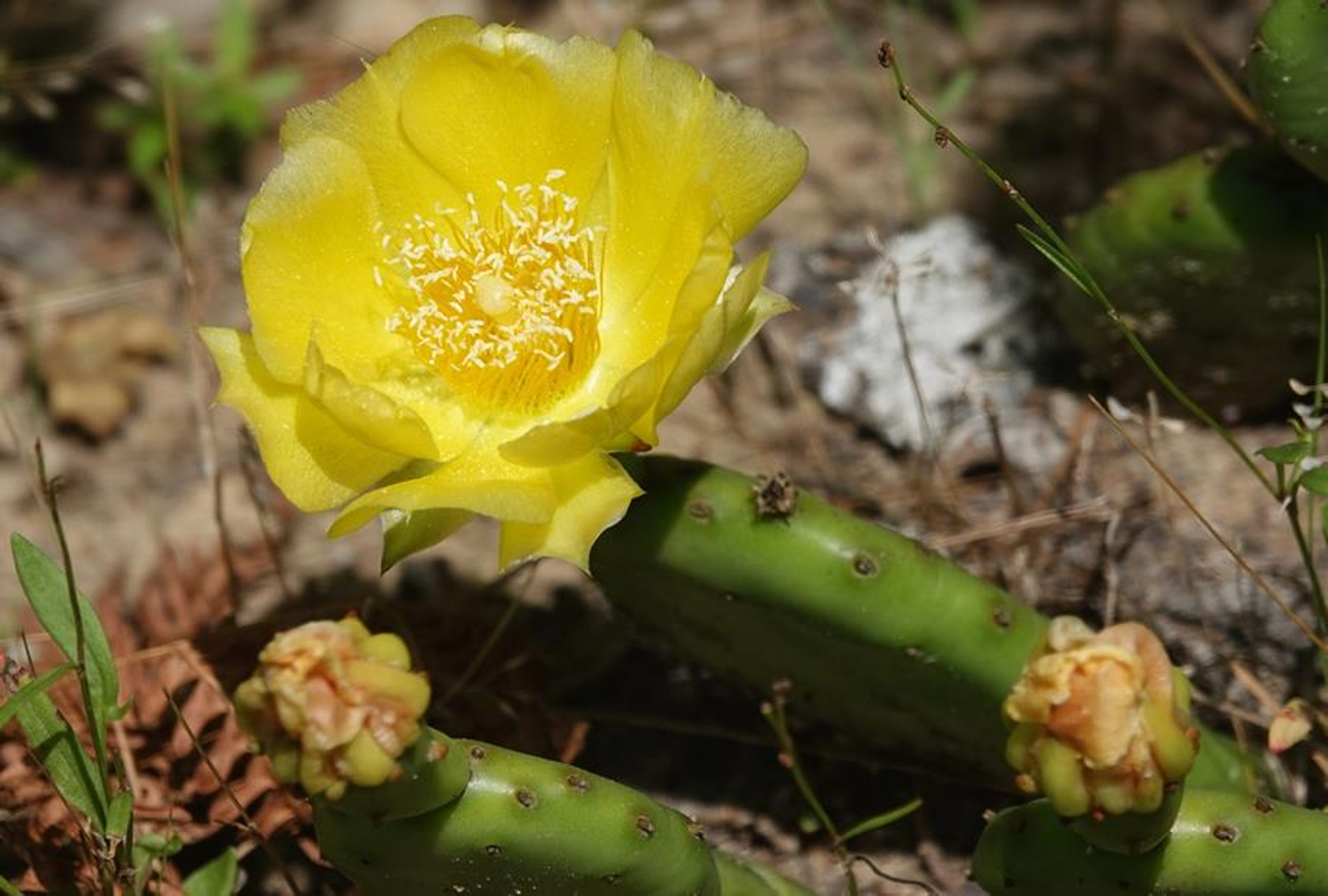Plant of the Month June 2024: Southeastern Prickly-pear Cactus
Southeastern Prickly-pear Cactus, Opuntia mesacantha
2024 June Plant of the Month
Northern Neck Chapter of the Virginia Native Plant Society
By Betsy Washington
The incredibly showy flowers of the Southeastern Prickly-pear Cactus light up a June afternoon (by B. Washington)
Southeastern Prickly-pear Cactus, is certainly eye-catching when in bloom in late May and June and curious and just plain cool at any time of year. This native evergreen is technically a “shrub” although it grows only 6 – 12” high. It is indeed a member of the cactus family and part of a complex of confusing Prickly-pear species, of which three very similar species occur in Virginia – all with succulent, flattened evergreen stems and leaves. Two of these species, Southeastern Prickly-pear, O. mesacantha var. mesacantha, and Common or Eastern Prickly-pear, O. humifusa occur in the Coastal Plain of Virginia and are locally common in dry sandy habitats such as dunes, sandy roadsides and clearings and sand hills. They also occur infrequently in the Piedmont. The third Virginia species, Eastern Prickly-pear, O. caespitosa, occurs in the Ridge and Valley region of the mountains but in shallow rocky soil and granite outcrops.
In all three species, the stems are distinctively flattened into segments or pads up to 10” long (technically called ‘cladodes’ – who knew) that could be mistaken for very thick fleshy leaves. Each pad is rounded or oblong and tapered at the base and contains clusters of minute barbed reddish-brown bristles embedded in tiny clusters of woolly hairs. The pads are filled with a watery sap and function as both a site for water storage and photosynthesis. They have fibrous roots and form large colonies of prostrate or trailing pads often branching in all directions. All three species have incredibly showy, yellow flowers that can be 2–3” in diameter, held either singly or in clusters at the ends of the pads. The two coastal Plain species found in our area of Virginia have stunning pure yellow flowers while O. caespitosa stands apart in having yellow flowers that are distinctly red at the base of the petals. The petals in all have a waxy texture and the petals, sepals and dense cluster of stamens in the center are entirely bright yellow. The flowers are followed by showy large edible red to burgundy-purple berries that ripen in fall. The berries are 1 – 3” long and barrel or club-shaped containing relatively large seeds. Pads wrinkle and turn purplish-gray-green in winter.
A main difference between the two coastal plain species is the spines or lack thereof on the pads: Southeastern Prickly-pear, O. mesacantha, has at least a few long whitish spines that are stout and up to 1 inch long while Common Prickly-pear, O. humifusa, does not have spines. Both, however, have clusters of barbed bristles on the pads.
The Prickly-pear complex (until recently all called O. humifusa) has a surprisingly large range from Massachusetts to Florida west to Montana and New Mexico and even north into Ontario. The taxonomy has long been confused due to widespread variability in characteristics and hybridization but a recent revision of the complex in 2017 has defined 3 species in Virginia. The distribution in Virginia is somewhat unclear and will remain so until herbaria specimens can be re-examined in light of this study but O. mesacantha seems to be the most common species in Northern Neck and the Middle Peninsula. The two species have been confused in the past and may be sold under the name O. humifusa in nurseries.
Besides being an amazingly unusual plant, Prickly-pear Cacti are incredibly heat, drought, and salt tolerant and are easy to transplant and grow in dry sandy soils in full sun. They are perfect for drought-tolerant (xeriscape) gardens, edible or rock gardens, or on dry slopes, or even for use in containers and have no major pest or disease problems. Propagate them by division, by planting a detached pad, or from seed. They will readily colonize dry sandy soils spreading up to 3’ in diameter. Thick gloves are recommended in handling the plants as not only may they have long, stout spines, but the barbed bristles embedded in clusters of woolly hairs are extremely difficult to remove and can cause extreme irritation.
The pads, fruit, and flowers are edible, just use care and be sure to remove all of the spines and bristles beforehand. They can be boiled or grilled or made into juice or jams. Prickly-pear cacti have been touted as having super nutritional and medicinal value and whether these claims are true, they do have high amounts of fiber, anti-oxidants and carotenoids. The Mayo Clinic sums up some of the science behind health claims by saying “there is some evidence that prickly-pear can reduce blood sugar levels in some people with Type 2 diabetes and potentially reduce the unpleasant effects of a hangover, maybe because of their anti-inflammatory properties.” As in everything, moderation is advised as some people may experience mild diarrhea and other side effects.
The flowers attract several species of bees including bumblebees as well as butterflies while the berries provide food for a variety of birds and other wildlife. However, this intriguing and adaptable cactus and its stunning flowers and fruit are reason enough to find a special spot in your garden for this unusual native plant.
Southeastern Prickly Pear Cactus with Showy Blooms and spiny pads (by Maeve Coker)
Beetles seeking pollen (by Betsy Washington)
Glochidia with barbed bristles (by Kevin Howe)
Spines of Southeastern Prickly-pear (by Maeve Coker)
Southeastern Prickly-pear Cactus edible fall berries and spiny pads (by Maeve Coker)
Spineless pads of Common Prickly-pear (by M. Coker)
Reddish base of petals of O. caespitosa (USDA by David Taylor)








